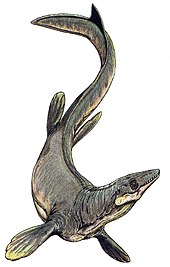Plioplatecarpus
| Plioplatecarpus Temporal range: Late Cretaceous,
| |
|---|---|

| |
| P. primaevus skull | |
| Scientific classification | |
| Kingdom: | |
| Phylum: | |
| Class: | |
| Order: | |
| Family: | |
| Subfamily: | |
| Genus: | Plioplatecarpus
|
| Species | |
| |
| Synonyms | |
| |
Plioplatecarpus is a genus of mosasaur lizard. Like all mosasaurs, it lived in the late Cretaceous period, about 73-68 million years ago.
Description

Plioplatecarpus was a medium-sized mosasaur, measuring 3.9–5 m (13–16 ft) long and weighing 170–350 kg (370–770 lb).[1] The eyes of Plioplatecarpus are proportionally larger than those of many mosasaur genera, although the skull is relatively short. The larger eyes may be an adaptation to low light conditions like those found in deeper water. It has fewer teeth than most mosasaurs, but they are greatly recurved. This suggests that Plioplatecarpus would have hunted relatively small prey that it could grab very precisely. The broad distribution of fossil remains in both North America and Europe suggest that it would have been an open ocean predator.[citation needed]
Discovery
Plioplatecarpus was first found in Europe by paleontologist Louis Dollo (P. marshi), in 1882. It was relatively incomplete, but more fossils would soon turn up. In North America, Edward Drinker Cope found another mosasaur in 1869, but had identified it as Mosasaurus. It would later be reclassified as Plioplatecarpus, as would Cope's Liodon, in 1870. Liodon would be reclassified as Platecarpus, and later as Prognathodon. However, some have placed it in the genus Plioplatecarpus.[2][3] There has been a record of an incomplete specimen of Plioplatecarpus from a non-marine deposit, suggesting that this genus might have entered freshwater and estuarine habitats.[4]
Distribution

Plioplatecarpus has been found in many locations around the world (most mosasaurs were fairly widespread). Plioplatecarpus has been found in the Pierre Shale of Kansas, Demopolis Chalk of Alabama, and also in Mississippi, North Dakota, South Dakota, Canada, Sweden, The Netherlands.
References
- ^ Paul, Gregory S. (2022). The Princeton Field Guide to Mesozoic Sea Reptiles. Princeton University Press. pp. 170–171. doi:10.1515/9780691241456. ISBN 9780691193809. S2CID 251553177.
- ^ Oceansofkansas.com
- ^ Paleodb.org
- ^ Holmes, Robert; Caldwell, Michael W.; Cumbaa, Stephen L. (1999). "A new specimen of Plioplatecarpus (Mosasauridae) from the lower Maastrichtian of Alberta: comments on allometry, functional morphology, and paleoecology". Canadian Journal of Earth Sciences. 36 (3): 363–369. doi:10.1139/e98-112.

